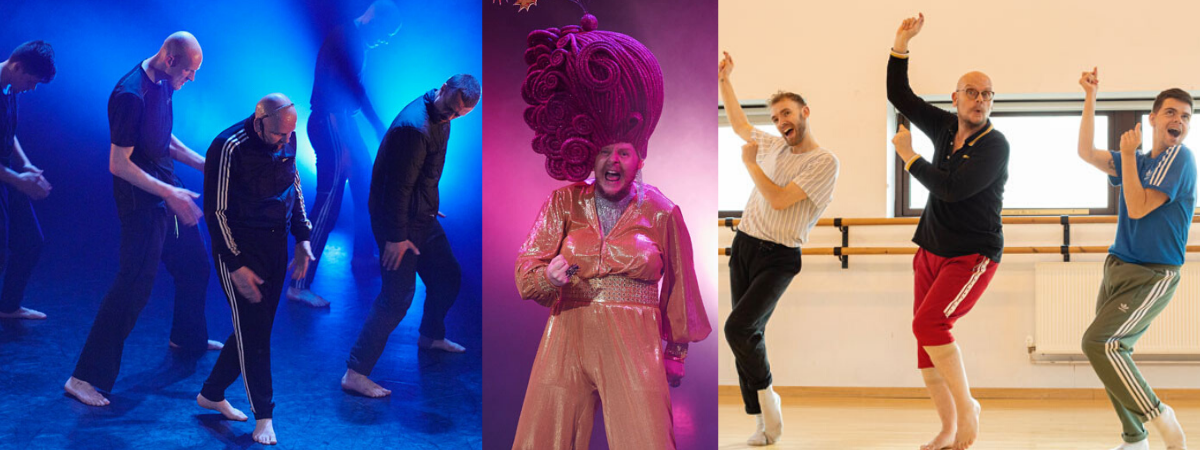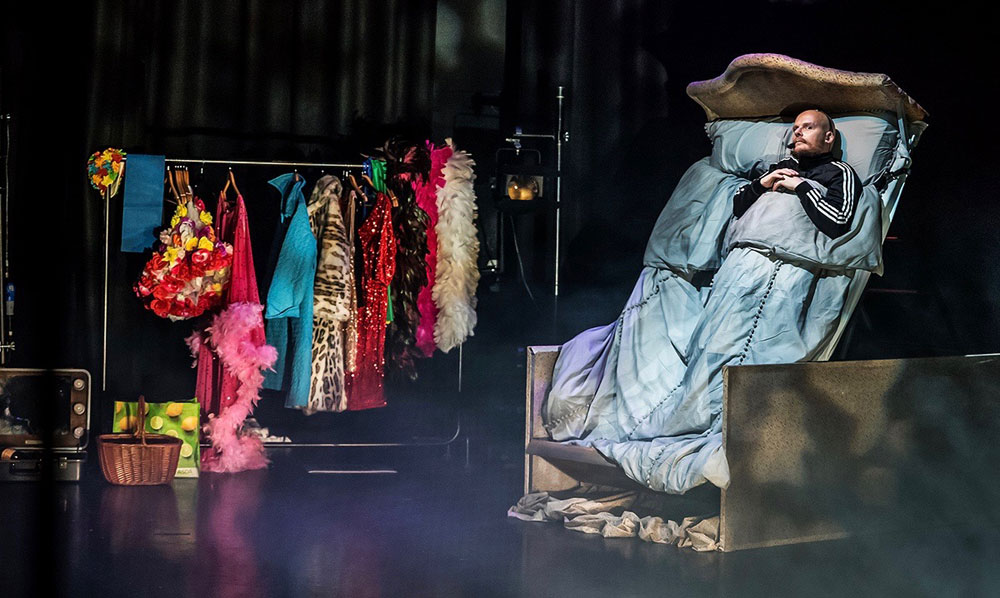“When I wake up, I know I’m gonna be, I’m gonna be, I’m gonna be in f****** pain. When I get up, I know I’m gonna need, I’m gonna need codeine, again and again. ‘Cos I can’t walk a flight of stairs and I can’t sit in certain chairs… Give me Codeine! Give me Codeine! De dum de de dum de dum de dum de dah”.
You could be forgiven for thinking I am touting for prescription drugs, but these are the opening words to my latest commissioned dance theatre work What Have YOU Done To Deserve This?, and I hope the reader guessed the tune correctly, it was to the Proclaimers famous hit. In the performance, I deliver a range of autobiographical reflections about my past to present day. The speech and words are carefully chosen and are vocally projected from an unusually positioned upright giant bed, placed among a visual feast of media projections, a haunting sound scape, alongside kitsch and camp drag costumes that anyone familiar with my work would expect! Choruses of codeine, choreography and camp punctuate the piece.
It was only towards the end of the creative process that I realised that the work was an eclectic mix of anger, aggression, camp, frivolity, humour, darkness and empowerment. My artistic mess was to become public performance. What had my audience done to deserve such an ordeal? And that’s how the piece was christened. Here lies a performance more akin to a Freudian playground of creative and psychological endeavours documenting my own experience of homophobia, classism and chronic pain. Delving further back into my past, I present the homophobia I experienced through a process of vulnerability. Using dance as artivism in this way allows for making visible what has often been hidden in performance: the perspectives of queer minorities. This is especially important given that it is Pride season. A range of invited alumni male dance students from Edge Hill University, who identify as gay, bisexual and straight, also participated in the dance theatre piece.

The performance work focused on lives and bodies in a constant state of oppression, resistance and endurance. The performance journey included five weeks of studio based devising processes with one evening of performing the work at Edge Hill Arts Centre, who generously commissioned the project. COVID-19 has currently halted the planning of a UK tour.
Narratives from minorities and marginalised groups still remain under-represented in performance work, especially in class or sexuality. Moreover, What Have YOU Done To Deserve This? as an autobiographical piece narrates my experiences of being shamed for my disability. I live, work and negotiate chronic pain through the effects of fibromyalgia, cervical spondylosis, chronic pelvic pain syndrome and chronic fatigue syndrome/myalgic encephalomyelitis. (Reader, note that this was quite a tough phrase to type that put my muzzy mind and the spell checker to work).
I present on stage exactly how disability and dance have become uncomfortable bed fellows, if you excuse the prop-based pun. The bodily and psychological impact of the above symptoms has resulted in significant joint stiffness, body wide muscle pain, cognitive disruption, swollen glands and now a need for a ‘second wave’ of revisiting my studio-based dance making practices. I say ‘second wave’ to appear a bit more lucid, but to be honest, I’ve lost count how many waves have crashed over my dancing body. My students now call me the ‘grandma of modern dance’. At least for once Martha Graham doesn’t get a look in! I must have taught them well.
In addition to my practice work exploring issues of identity renegotiation through life processes, my written academic work has focussed on these disruptions – age, mental health, body size, as well as performing minorities. My first monograph, Mesearch and the Performing Body (2018), explores how these issues were played out in three performance-based works. I’ve also written on the mental health disruptions that accompany bodily ruptures, in a co-authored book chapter with Dr Fiona Bannon, Being in Pieces: Integrating Dance, Identity and Mental Health in the Oxford Handbook of Dance and Wellbeing (2017).
Through the process of recognising the disruptions to my ability and desire to dance over the recent years, it is not surprising that I use the imperfect tense to describe what ‘I used to’ be able to do when ‘I was…’. But therein lies the rub. The grammatical structure is accurately described. It is simply imperfect; it describes a continuous action in the past that is no longer happening.
Historically I have the embodied contemporary dance lineages originating from north America and the array of post-modern and contemporary dance forms evolving from Europe during the 1980s. My dancing body reflects a mixing of contemporary dance practices with my own recreational dance in 1980s drag bars and illegal acid house raves. In recent years, being unwell and living with chronic illness has meant that various deeply embodied performance forms were disrupted, not to mention the renegotiation of daily physical activities.

My dancing identity and my dance education work was well established yet here I was slowly depicting the fragility of a human body and the tumultuous, disconcerting process of retranslating movement due to pain and a need for pain management. The age-old adage ‘my body is a temple’ hasn’t aged well for me, I think mine is a site of ruins. But, my body is an archive. I don’t romanticise a dancing past, nor do I pore over photographs showing me in my prime. Rather, my body serves as a rich vessel when choreographing for companies and mentoring emerging artists, undergraduate and postgraduate students and performing my works that move away from codified perfection and offer raw, organic presentations. In fact, part of me is relieved to be at this stage of my career. The benefit of this includes the ability to perform what I want, wearing what I want. In What Have YOU Done To Deserve This? I wore a comfortable tracksuit, itself a visual reminder of class consciousness and the myth and impossibility of hegemonic masculinities the piece intended to debunk.
So now, through my pained body, I work with a range of reflective movement practices that are less physically demanding and more holistic. It’s about keeping the mind healthy too. I flirt with meditational practices such as mindfulness and Buddhism. While I can’t say I am fully committed to anything, what I see before me is a buffet of practices that I have been nibbling on as a somatic endeavour.
To conclude, inconsistencies and inabilities do not necessarily indicate inadequacies. What Have YOU Done To Deserve This? has enabled me to explore a liminal third space where the trinity of decline (age, pain and imperfection) must continue to pave out new creative paradigms for this dancing body.
Info
Dr Mark Edward is a pracademic and Reader in Creative Arts at Edge Hill University. His current co-edited books include Contemporary Drag Practices and Performers: Drag in a Changing Scene and Drag Histories, Herstories and Hairstories: Drag in a Changing Scene (Bloomsbury, 2020).
Photo credits from top and left to right
- Mark Edward in What Have YOU Done To Deserve This? Photo: Stuart Rayner.
- What Have YOU Done To Deserve This? Photo: Stuart Rayner.
- What Have YOU Done To Deserve This? Photo: Stuart Rayner.
- Ted Wilkinson, Mark Edward and Ben Lee in rehearsals for What Have YOU Done To Deserve This? Photo: Geof Atwell.
- Mark Edward in What Have YOU Done To Deserve This? Photo: Brian Sayle.
- Mark Edward in What Have YOU Done To Deserve This? Photo: Brian Sayle.